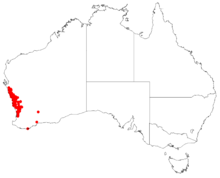Conostylis androstemma
| Conostylis androstemma | |
|---|---|

| |

| |
| Scientific classification | |
| Kingdom: | Plantae |
| Clade: | Tracheophytes |
| Clade: | Angiosperms |
| Clade: | Monocots |
| Clade: | Commelinids |
| Order: | Commelinales |
| Family: | Haemodoraceae |
| Genus: | Conostylis |
| Species: | C. androstemma
|
| Binomial name | |
| Conostylis androstemma | |

| |
| Occurrence data from AVH | |
| Synonyms[2] | |
|
Androstemma junceum Lindl. | |
Conostylis androstemma (common name trumpets)[3] is a tufted perennial plant species in the family Haemodoraceae. It is endemic to the south-west of Western Australia.[4] Plants grow to between 10 and 30 cm high and produce cream to pale yellow flowers between May and August in the species' native range.[3]
Description[edit]
Conostylis androstemma has green, hairless, terete leaves that are 10–30 cm (3.9–11.8 in) long and about 1 mm (0.039 in) in diameter. The flowers are borne on pedicels that are 4–6 mm (0.16–0.24 in) long, with bracts 8–10 mm (0.31–0.39 in) long and 2 mm (0.079 in) wide at the base.[4] The flowers are white to cream-coloured or yellow, 25–45 mm (0.98–1.77 in) long, hairy and radially symmetrical with lobes that are 15–22 mm (0.59–0.87 in) long.[3][4] The six stamens are in one level, the anthers 11–12 mm (0.43–0.47 in) long and the style 33–45 mm (1.3–1.8 in) long.[4][3] Flowering occurs from May to August.[3] The plant resprouts from its rhizomes, after fire.[4]
It is easily distinguished from Conostylis argentea by its terete hairless leaves.[4]
Taxonomy[edit]
Originally named Androstemma junceum and described by John Lindley in 1840 in A Sketch of the Vegetation of the Swan River Colony,[5][6] The species was assigned to the genus Conostylis by botanist Ferdinand von Mueller in 1873 in Fragmenta Phytographiae Australiae and renamed Conostylis androstemma.[7][8]
Distribution and habitat[edit]
Conostylis androstemma grows in lateritic gravel and yellow sand on screes and hilltops, and occurs in south-western Western Australia from Kalbarri National Park to Perth and York in the Avon Wheatbelt, Geraldton Sandplains, Jarrah Forest, Swan Coastal Plain and Yalgoo bioregions of south-western Western Australia.[3][4]
References[edit]
- ^ "Conostylis androstemma". Australian Plant Census. Retrieved 10 April 2024.
- ^ Govaerts, R., et al. (2019) Plants of the world online:Conostylis androstemma. Board of Trustees of the Royal Botanic Gardens, Kew. Retrieved 9 January 2019.
- ^ a b c d e f "Conostylis androstemma". FloraBase. Western Australian Government Department of Biodiversity, Conservation and Attractions.
- ^ a b c d e f g "Conostylis androstemma F.Muell". Flora of Australia Online. Department of the Environment and Heritage, Australian Government.
- ^ "Androstemma junceum". APNI. Retrieved 10 April 2024.
- ^ Lindley, John (1840). A Sketch of the Vegetation of the Swan River Colony. Piccadilly: James Ridgway. p. 55. Retrieved 10 April 2024.
- ^ "Conostylis androstemma". APNI. Retrieved 10 April 2024.
- ^ von Mueller, Ferdinand (1873). Fragmenta Phytographiae Australiae. Vol. 8. Melbourne: Victorian Government Printer. p. 19. Retrieved 10 April 2024.
